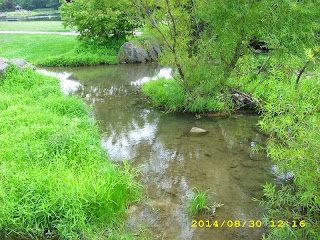.jpg)
The begging walk and the sign in front of the trail around the 5 acre pond.
Source: Debra Allen
Poor House Farm Park
Our Start
On Saturday we took a drive to the park that is near us. I took many pictures. It was quiet out there because they had the pond area blocked off because someone was going to be having a wedding that day. It is a gorgeous place to have a wedding that is for sure and you can bank on that. Well we got to walk through it and I took some very nice pictures. I, at first, did not think that they would turn out well. I was very pleasantly surprised when I got home and uploaded them onto my computer so that I could see them. They are gorgeous, if I say so myself. Now, I used a digital camera for all these pictures. I do have a much more powerful camera but I keep forgetting how to load the film in it. The last time that I did that, I took three rolls of photos and when I went to have them developed there was nothing on the film. I followed the directions and everything. I took off the protector even. I wasted all the precious time and all that money. So I don’t use that one anymore. I wish that I could but maybe some other day.
Used to be Mountainside Group Home

This house was used as the Group Home up until the year 2001 when the County took it over to make it part of the Park.
Source: Debra Allen
Poor House Farm Park has an interesting history with it.
One of the houses has been used as a Mental Health Facility Group Home.
That closed a few years ago, and the name of that was Mountainside Group Home.
It was part of the Eastridge Mental Health Facility’s program.

Poorhouses
Poorhouses were pre-welfare times. They were used to house those who could not pay their taxes and give the tax payers an alternative means to support the poor. These places were managed by an elected official of the town where the poorhouses were located. The manger or overseer title was “Poor Master.” It was only here that there would be people who would be in long term need of housing. For those who did not need such long term facilities they were given a relief, but had to ask for it. It was run similar to the Welfare System that we have today, only there was no such thing as homelessness unless they were caught begging in public places. They would be turned out to live individually…..homeless. I think that this was the real reason why people shun the homeless today. Hmmm, would we need to bring this type of help back? I wonder. We do have homeless shelter, but not everyone can accommodate the amount of those who have become homeless in this generation.
Poor House Farm Park 5 Acre Pond
.jpg)
A view of the Pond and the surrounding mountain and trees.
Source: Debra Allen
Origins of Landowners
An article that I found on the internet here, History of Poorhouses, tries to clear up the differences between debtors prison and poor houses and states, “One misconception should be cleared up here; they were nottechnically "debtors' prisons." Someone could owe a great deal of money, but if they could still provide themselves with the necessities for remaining independent they might avoid the poorhouse.”
Poor House Farm was on 400 acres of land west of Martinsburg, WV. It was owned by Davey Crockets Grandparents. David and Elizabeth Crocket were granted the 400 acres of land by Lord Fairfax in 1766. As the story goes that land changed hands many times over. Eventually through all the transfers it finally ended up being owned by John and Elizabeth Emmert. Most of the houses that were on the piece of land now known as Poor House Farm Park were made of logs. Eventually they were made of limestone. I do not know if they were re-built or just layered in the stone. They are re-building or re-furbishing the house that used to be the group home for the county.
The Football Field
.jpg)
Poor House Farm Park Football Field back-dropped near the mountain.
Source: Debra Allen
Today's Poor House Farm Park
The Emmert’s sold 140 acres to the Berkeley County in 1850 and in 1960 the Stewart house was built using bricks. When the state decided to begin the Welfare Program the poorhouses were outdated. Soon after that the houses were leased to private residents. The Mountainside House was a group home up until the year 2001 when the county took back all the land and started making it into the lovely park that it is today.
Poor House Farm Park
.jpg)
Houses and buildings
Source: Debra Allen
Just Sharing
There is so much to do there and yet
I just wanted to take a leisurely walk through the park with my husband and our dog.
The surroundings are so peaceful and serene and
I just love taking pictures and sharing them with others.
So you do enjoy the pictures that I am sharing.
Recreation In Poor House Farm Park
The park now consists of:
· One Large pavilion
· One medium pavilion
· 5 miles of hiking that meanders through a beautiful wooded area
· Emmert Field youth football complex
· Practice fields for soccer and base/soft ball
· Volleyball court in sand
· 18 hole disk golf course
· Henry Equestrian Arena
· A 5 acre pond filled with trout
Other Pictures That I took On My Walk
.jpg)
The Gazebo
Source: Debra Allen

.jpg)
.jpg)
The local residents.
Source: Debra Allen
More Information About Poor House
· HISTORY of Poorhouses
Poorhouses promised to be a much more efficient and cheaper way to provide relief to paupers.
· The Barn at Poor House Farm
· Find A Grave: Poor House Farm Cemetery #1, #2, #3
© Debra K. Allen a.k.a Lady Guinevere
I researched and wrote this article. Please do not copy and paste any part of this article, picture included for your own use. I will find you and report you for stealing. It is my right to change any information therein at any time and/or change the location of my article.
No comments:
Post a Comment